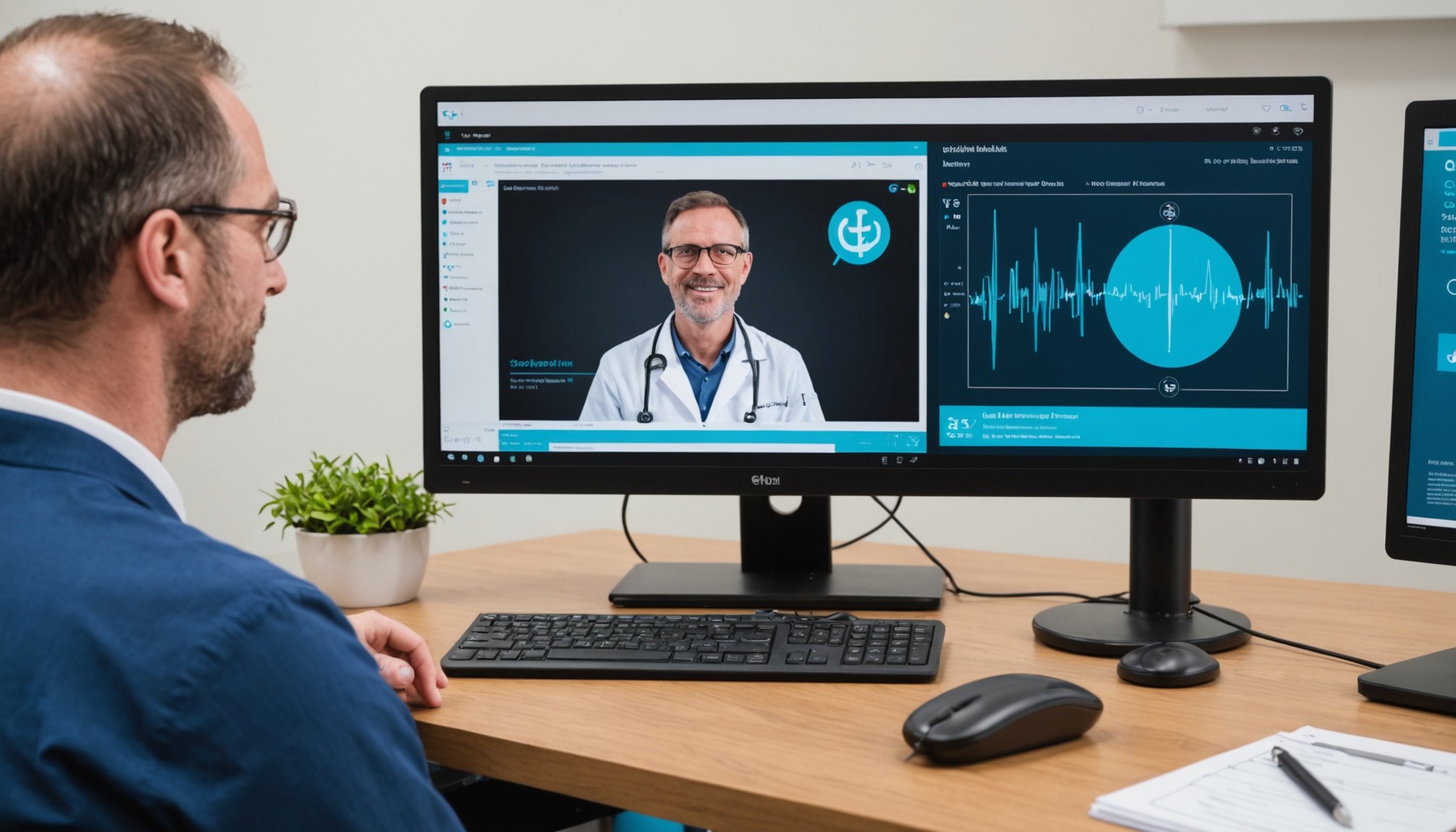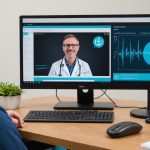Overview of Telehealth Innovations in Sheffield
Telehealth innovations have significantly transformed modern healthcare, particularly in Sheffield. They represent the integration of digital health technologies, which enable healthcare providers to deliver medical services remotely. This approach has become especially critical, enhancing accessibility and efficiency within the healthcare system.
In Sheffield, healthcare providers have embraced a variety of technological advancements. These include virtual consultations, remote monitoring, and electronic health records. Such innovations allow healthcare practitioners to monitor patients’ health remotely, reducing the need for in-person visits. This not only streamlines service delivery but also offers patients greater flexibility and comfort.
Also to see : Revolutionizing retail: a comprehensive guide to augmented reality try-ons for leeds shoppers
The impact of telehealth on healthcare service delivery in Sheffield is substantial. By employing these technologies, healthcare facilities can reach more patients, including those in remote areas, thereby improving overall public health outcomes. Additionally, the use of digital health technologies aids in managing chronic conditions and delivering timely interventions.
Sheffield healthcare providers continue to leverage telehealth to enhance patient experience and satisfaction. This approach provides a sustainable solution to the increasing demand for medical services, positioning Sheffield as a leader in the field of digital health technologies. Telehealth thus offers a promising future for healthcare, combining innovation with essential care services.
Also to read : Unlocking exceptional customer experiences: proven techniques for manchester”s premier spa
Examples of Telehealth Technologies in Use
Telehealth technologies have revolutionised how healthcare is delivered, making it more accessible for patients and effective for clinicians. Sheffield healthcare providers are at the forefront, utilising a range of remote care solutions to enhance patient care.
Video Consultation Platforms
Video consultation platforms are a cornerstone of telehealth technologies. They facilitate real-time communication between Sheffield healthcare providers and patients. These platforms enable clinicians to conduct appointments as they would in-person, offering diagnosis, treatment recommendations, and even prescriptions. The primary benefits include:
- Convenience for patients who can attend appointments from home.
- Efficiency for clinicians to manage appointments more flexibly.
Remote Patient Monitoring Tools
For chronic condition management, remote patient monitoring tools have proven invaluable. These technologies enable clinicians to track vital signs such as heart rate and blood sugar levels. By using data collection strategies and engaging patients through regular updates, these tools help maintain the continuum of care outside traditional settings.
Mobile Health Applications
Mobile health applications are vital components of remote care solutions. Sheffield providers have implemented popular apps designed to enhance patient accessibility. These apps offer features like appointment scheduling, medication reminders, and access to healthcare records. By fostering interaction, they empower patients to take an active role in their health management.
Case Studies of Successful Telehealth Implementations
Exploring real-life telehealth success stories can highlight significant advancements in patient care improvements. Sheffield providers like the NHS Trust have demonstrated effective telehealth integration, showcasing the benefits through several compelling case studies. This implementation aimed at improving access to healthcare while maintaining high-quality service.
Before integrating telehealth solutions, patient outcomes often suffered due to geographic and logistical barriers, leading to delayed treatment and lower patient satisfaction. However, post-implementation, there was a marked improvement in patient satisfaction scores and a noticeable reduction in appointment no-shows.
Key learnings from these case studies emphasize the importance of robust digital infrastructure and comprehensive training for healthcare professionals. By ensuring these foundational elements are in place, providers witnessed enhanced doctor-patient communication and more efficient management of chronic illnesses.
Some best practices include:
- Ensuring technology is user-friendly to foster patient engagement.
- Prioritizing data security and privacy to build patient trust.
- Implementing regular feedback loops to continuously refine the telehealth system.
These examples from Sheffield serve as a blueprint for other regions aiming to replicate such success, contributing to the broader discourse on transforming healthcare delivery through technology.
Statistics on Patient Outcomes
The evolution of telehealth has significantly impacted how patients interact with healthcare services. Patient outcomes indicate a profound shift.
Improvement in Access to Care
Telehealth has drastically improved access to care, expanding healthcare services to previously underserved areas. Recent data reveals a surge in usage, particularly among demographics with limited healthcare access. The utilization rates of telehealth services have increased by 25% across various sectors, highlighting a remarkable demographic shift towards remote healthcare solutions. This shift is not only statistical but also practical, demonstrating tangible improvements in patient engagement and access.
Patient Satisfaction Rates
An interesting survey conducted among telehealth users in Sheffield indicates high levels of patient satisfaction. These surveys reveal that over 80% of patients rated telehealth services positively, often citing convenience and immediate access to health professionals as primary advantages. When comparing satisfaction rates between in-person and telehealth visits, many patients favoured the latter due to reduced travel times and waiting periods.
Health Outcomes Metrics
Statistical trends suggest a notable enhancement in health outcomes through telehealth interventions. Particularly, longitudinal studies underline significant improvements in managing chronic diseases like diabetes and hypertension. These studies further confirm that persistent telehealth use leads to more consistent monitoring and tailored treatment, culminating in better overall patient health. Such strategies ensure patients receive continuous quality care, directly impacting positivity in healthcare improvements.
Testimonials from Healthcare Professionals and Patients
In the rapidly evolving world of telehealth, testimonials from both healthcare professionals and patients highlight its profound influence. Healthcare providers often express that telehealth technologies enhance their ability to deliver care effectively and flexibly. One clinician remarked, “Telehealth has revolutionised patient interactions, making healthcare more accessible and responsive to individual needs.”
For many patients, transitioning to telehealth services has been a significant shift. Initially daunting, this move is often viewed positively in retrospect. A patient’s perspective revealed, “While I was sceptical at first, telehealth services offered me convenience and the same level of care, all from the comfort of home.” Such experiences underscore the adaptability and advantages these technologies extend to various patient demographics.
Furthermore, insights into communication and relationship building in a telehealth setting are pivotal. Healthcare professionals emphasize that maintaining a strong patient-provider relationship is feasible through virtual means. Effective communication is crucial, with one healthcare provider noting, “We’ve become adept at picking up on non-verbal cues during video consultations, ensuring our patients feel heard and supported.”
These patient perspectives and healthcare provider feedback collectively showcase how telehealth is reshaping care, making it more patient-centric while upholding the quality of interactions and relationships.
Challenges Facing Telehealth Adoption
Telehealth, while transformative, faces significant barriers to implementation. One primary issue is the technological barrier. For many patients and providers, access to reliable internet and compatible devices is inconsistent, thereby limiting the effectiveness of telehealth services. This digital divide can hinder the delivery of care, especially in underserved communities where resources are scarce.
Another challenge lies in regulatory and reimbursement issues. Telehealth development is often stifled by varying regulations across regions, adding complexity to service provision. Furthermore, inconsistent reimbursement policies create uncertainty for healthcare providers seeking to adopt these technologies. These multifaceted issues not only slow down the widespread integration of telehealth but also discourage innovation within the field.
Health equity issues also play a central role in the adoption of telehealth. Accessibility remains a critical concern, as individuals in remote or economically disadvantaged areas might not have the means to benefit from telehealth services. Thus, the gap between those who can access quality healthcare and those who cannot may widen further if solutions are not implemented.
Addressing these telehealth challenges with a comprehensive strategy could enhance healthcare delivery. Efforts must be made to improve infrastructure, standardize regulations, and ensure equitable access to telehealth services for all individuals, irrespective of their location or economic status.
Future Prospects of Telehealth in Sheffield
The future of telehealth in Sheffield is poised for significant advancements, driven by continuous innovation in healthcare. Telemedicine prospects are expanding, with promising implications for both patients and healthcare providers. These innovations include new platforms for interactive consultations and advanced tools for remote monitoring, enhancing accessibility and efficiency in medical practices.
Emerging Technologies on the Horizon
Several technological trends are set to revolutionize telehealth. These include the integration of artificial intelligence (AI) for data analysis and personalized healthcare recommendations. Improved regulatory frameworks are anticipated to support wider adoption, ensuring that telehealth services align with privacy and ethical standards.
Integration with Traditional Healthcare Services
Efficiently merging telehealth with in-person care can lead to comprehensive patient management. Strategies involve coordinating digital health services with physical consultations, ensuring continuity of care. This integration not only expands access but also optimizes resource use, ultimately improving patient health outcomes.
Community and Provider Engagement
Engaging both local communities and healthcare providers is crucial in shaping telehealth’s evolution. Initiatives like educational workshops and collaborative planning sessions can elevate telehealth literacy and acceptance. Healthcare providers play a pivotal role in championing these technologies, ensuring they meet community needs while fostering an adaptable healthcare environment in Sheffield.











